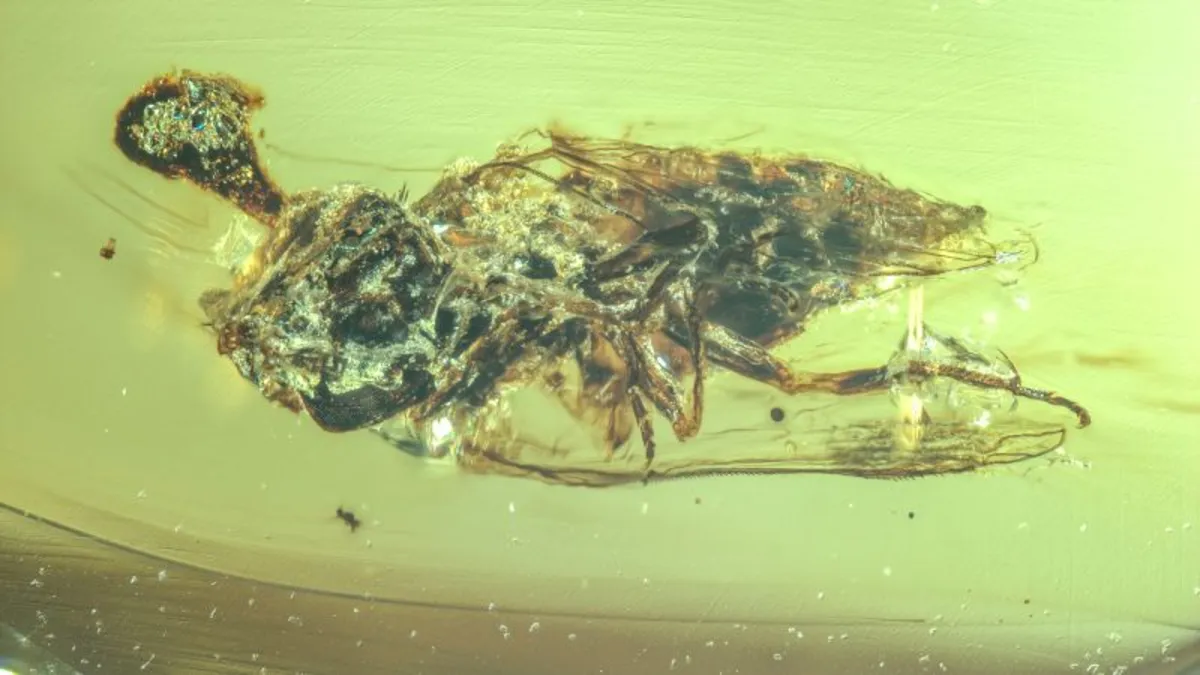
Sign up for CNN’s Wonder Theory science newsletter to explore the universe and stay updated on fascinating discoveries and scientific advancements. Recently, a glob of 99 million-year-old amber has revealed an astonishing sight: an ancient fly ensnared in a dramatic display, complete with the mushroom-like fruiting body of a zombie fungus bursting forth from its head. This remarkable find, alongside a second specimen of a young ant infected with a similar fungus, represents some of the oldest examples of a peculiar natural phenomenon where fungal parasites take over their hosts before ultimately leading to their demise.
“Amber provides us with a unique opportunity to visualize ancient ecological relationships preserved in fossils,” explains Yuhui Zhuang, a doctoral student at the Institute of Paleontology at Yunnan University in southwestern China. Zhuang, the lead author of a study published on June 11 in the journal Proceedings of the Royal Society B: Biological Sciences, notes the rarity of these fossils: “Overall, these two specimens are exceptionally rare among the tens of thousands of amber specimens we’ve examined, particularly in showcasing the symbiotic relationship between fungi and insects.”
Through meticulous research utilizing optical microscopes and micro-computed tomography to create 3D images of the fungi-infected insects, Zhuang and his colleagues identified two previously unknown species of ancient fungi from the genus Ophiocordyceps. The first species, named Paleoophiocordyceps gerontoformicae, was discovered on the ant, while the second, Paleoophiocordyceps ironomyiae, was found on the fly. Modern-day species of Ophiocordyceps, often dubbed “zombie-ant fungi,” are capable of manipulating the behavior of ants for their own reproduction and spread. This phenomenon has even inspired the popular video game that led to the HBO series The Last of Us.
Zhuang emphasizes the implications of this discovery, stating, “The finding of these two fossils indicates that terrestrial ecosystems were already quite complex during the Cretaceous period. It suggests that Ophiocordyceps may have begun acting as predators of insects, thereby regulating certain insect populations.”
Today, parasitic fungi, also known as entomopathogenic fungi, target various insect groups, including ants, flies, spiders, cicadas, and beetles, according to the Natural History Museum in London. For instance, in carpenter ants, the spores of the Ophiocordyceps fungus attach to the ant’s head, infiltrate its brain through a vulnerable area in the exoskeleton, and take control of the ant’s behavior to facilitate the fungus’s propagation. According to Conrad Labandeira, a senior scientist at the Smithsonian Museum of Natural History, the ancient Paleoophiocordyceps likely zombified its hosts in similar ways.
Labandeira notes, “It seems that ants were targeted early for zombification, and they currently remain the primary hosts for this type of parasitoid fungus.” Interestingly, flies are infrequently affected by these fungi today, making a fossilized example particularly noteworthy. The species of fungus that infected the prehistoric ant may have been an ancestor of modern-day zombie-ant fungi, suggesting it exerted similar control over its host.
Very few specimens of ancient parasitic fungi have been discovered, leaving much to learn about their evolution. The two insects likely succumbed to the fungi before becoming trapped in the sticky tree resin that eventually formed amber, as noted by study coauthor João Araújo, a mycology curator at the Danish Natural History Museum. Araújo highlights the significance of this lost parasite diversity in shaping contemporary ecosystems: “While we uncover a remarkable variety of organisms encased in amber, it’s crucial to acknowledge that we capture only a fraction of the broader ecological picture.”
As exciting as these amber fossils are, they also raise ethical concerns regarding their provenance, especially given the civil unrest in Myanmar, the source of these specimens. Zhuang clarified that the fossils were sourced from Myanmar’s amber markets, acquired prior to 2017, and were not associated with any armed conflicts or ethnic strife, to the best of the authors’ knowledge.
In conclusion, the discovery of these amber-encased fossils not only sheds light on ancient ecological interactions but also adds depth to our understanding of the complex relationships between species that existed during the age of dinosaurs. This research opens new avenues for exploring the evolution of parasitic fungi and their impact on ecosystems both past and present.